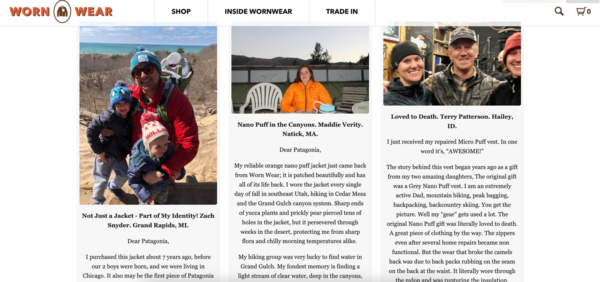
Every customer has the potential to alter perceptions of your business positively or negatively. When handled proactively, their word-of-mouth influence can be a powerful tool for your content marketing team.
Not only is word-of-mouth marketing much more cost-effective than paid strategies, it can produce a greater impact in the short and long term. Research from Kantar found that 93% of consumers say they trust their family and friends and 91% trust review sites for brand and service information. Advertising was at the bottom of the list – only 38% say they trust it.
90+% of consumers trust family, friends, and review sites for brand and service information, according to @Kantar via @CallRuby @CMIContent. Click To Tweet
Companies using authentic reviews and user-generated content from their customers in their content marketing tactics bolster their own reputation while expanding their customer base.
Here are four ways to incorporate word-of-mouth marketing into your content:
1. Feature relevant user-generated content
Done well, user-generated content can be perfectly authentic and make an impact. Reshare social shout-outs about your business. This is a low-effort way to draw attention to the public affection your business is garnering. But don’t stop there:
- Identify content that focuses on the service or product you provide. Look for content that shows the customer using or benefitting from your service or product. That type of “use-in-context” content can be invaluable.
- Elevate customer stories that involve your brand as a whole or your products/services. Follow up with customers who have shared their opinions publicly to see if they want to tell their stories in more detail. Make them the star of the story – let them do the explaining so that your brand doesn’t have to.
Resharing #social shout-outs about your business is a low-effort content marketing strategy, says @CallRuby via @CMIContent. Click To Tweet
TIP: Word-of-mouth content does not have to rely on lengthy reviews. Even a photo with a brief, positive caption can work.
Example: The Home Edit organizing brand, which has a Netflix show, created an Instagram post with this positive quote from Katherine Sivells: “Thanks to @TheHomeEdit, when I open a drawer or closet, I find myself saying, ‘We need to call Sumner.’ Then I realize it’s not “we,” it’s me and I don’t have Sumner’s number.”
2. Engage in real-time conversations
Your content marketing team should pay attention to customers’ social media posts even when they relate to customer service, not marketing. You can amplify the reach of customer feedback by engaging in the moment. Not to mention, responsiveness can quickly turn a negative into a positive when you can resolve or clarify a situation.
To join the conversation with customers, consider these strategies:
- Monitor mentions in real-time so you can join the conversation as it’s unfolding and address it if you want the conversation to end or propel the talk to keep it going. Customers value responsiveness highly – a HubSpot survey found that 90% rate an immediate response as important or very important when they have a customer service question.
- Thoughtfully insert yourself into the conversation. Whether a customer is putting out a call for help, asking a question, showing off your product, or talking about a great experience, engage authentically rather than hijacking the conversation. Answer the question, provide assistance, say thanks, and talk about why you love the product, too. If the natural opportunity is truly there, you may be able to share details about a new product or service.
- Sound like a person, not a company. Brands that do well in real-time conversations with customers are those that come across as a person, not a corporate brand. These conversations are not the time to sell your branded messaging. These are the opportunities to show off your personality, brand values, and commitment to your customers.
Example: Online pet supply company Chewy replied to a tweet from a customer remarking about their cat sitting in the small box rather than the bigger (Chewy-branded) box. They didn’t talk about their cat-related supplies or how to order and get a box. Instead, they responded with “You know what they say, if it fits I sits,” and a cat emoji.
You know what they say, if I fits I sits.
— Chewy (@Chewy) March 31, 2022
@Chewy is a brand that gets its #social voice right, replying to customers’ tweets with a personal voice, not a corporate brand, says @CallRuby via @CMIContent. Click To Tweet
3. Build stories around customer reviews
People are inspired to write reviews because of outstanding (or poor) service, and many customers won’t make a purchase without looking at reviews. So those stellar customer reviews you already have? Proudly use them in your content – with the permission of the customer.
- Find the reviews that most accurately describe your brand and what you do and build stories around them. Elevate across social channels, your blog, and your newsletter.
- Look for a customer with a specific problem or need that your company was able to solve. Add context to the review by sharing any behind-the-scenes work that went into solving the challenge.
- Convert standout quotes from customers into visual posts for social media.
- Turn multiple reviews into a content series by coupling together similar reviews to tell one story that demonstrates your company’s service consistency.
Example: Patagonia actively encourages customers who use its Worn Wear repair service to tell the stories behind their repaired garments. One customer writes about her Patagonia nano puff jacket. Within her colorful back story: “Sharp ends of yucca plants and prickly pear pierced tens of holes in the jacket, but it preserved through weeks in the desert, protecting me from sharp flora and chilly morning temperatures alike.”

Example: At my company, we used feedback from SensoryKidz, an occupational therapy business, for this Instagram post. The visualized quote – “I was doing five things at one time. When the phone rang, I had to go into therapist mode – even though I’m not a therapist – because families are anxious to get something done,” Mike said, jokingly adding, “we need more Mikes.” The accompanying caption went into more details about what SensoryKidz is and why its owners need our virtual receptionist services.
4. Create and share video testimonials
Customer videos can be a valuable asset in your content marketing strategy. Like other forms of word-of-mouth content, they can serve as a vetting source for potential customers. When done well, they deliver personal narratives where future customers can see themselves or their problems being solved. These videos also can be used in multiple ways:
- Feature full video testimonials on your company’s website. They can be paired with a brief write-up or as part of a larger case study.
- Share snippets of the video on social media with perfectly edited soundbites that feature how your brand delivers on expectations.
- Create a thematic blog post series around the content from these videos.
- Build your audience on YouTube (and other video streaming services). This content can then be leveraged in your search engine optimization and your Google My Business profile.
- Use in your email outreach.
Get your customers talking
Word-of-mouth marketing is one of the best tools in content marketing. When your customers do the talking, posting, and sharing, your customer base is likely to grow. The key is to effectively plan, incorporate, and repackage this user-generated content to deliver bigger results for your brand.
Cover image by Joseph Kalinowski/Content Marketing Institute




